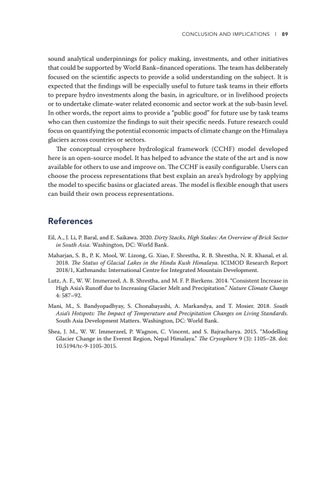Conclusion and Implications l 89
sound analytical underpinnings for policy making, investments, and other initiatives that could be supported by World Bank–financed operations. The team has deliberately focused on the scientific aspects to provide a solid understanding on the subject. It is expected that the findings will be especially useful to future task teams in their efforts to prepare hydro investments along the basin, in agriculture, or in livelihood projects or to undertake climate-water related economic and sector work at the sub-basin level. In other words, the report aims to provide a “public good” for future use by task teams who can then customize the findings to suit their specific needs. Future research could focus on quantifying the potential economic impacts of climate change on the Himalaya glaciers across countries or sectors. The conceptual cryosphere hydrological framework (CCHF) model developed here is an open-source model. It has helped to advance the state of the art and is now available for others to use and improve on. The CCHF is easily configurable. Users can choose the process representations that best explain an area’s hydrology by applying the model to specific basins or glaciated areas. The model is flexible enough that users can build their own process representations.
References Eil, A., J. Li, P. Baral, and E. Saikawa. 2020. Dirty Stacks, High Stakes: An Overview of Brick Sector in South Asia. Washington, DC: World Bank. Maharjan, S. B., P. K. Mool, W. Lizong, G. Xiao, F. Shrestha, R. B. Shrestha, N. R. Khanal, et al. 2018. The Status of Glacial Lakes in the Hindu Kush Himalaya. ICIMOD Research Report 2018/1, Kathmandu: International Centre for Integrated Mountain Development. Lutz, A. F., W. W. Immerzeel, A. B. Shrestha, and M. F. P. Bierkens. 2014. “Consistent Increase in High Asia’s Runoff due to Increasing Glacier Melt and Precipitation.” Nature Climate Change 4: 587–92. Mani, M., S. Bandyopadhyay, S. Chonabayashi, A. Markandya, and T. Mosier. 2018. South Asia’s Hotspots: The Impact of Temperature and Precipitation Changes on Living Standards. South Asia Development Matters. Washington, DC: World Bank. Shea, J. M., W. W. Immerzeel, P. Wagnon, C. Vincent, and S. Bajracharya. 2015. “Modelling Glacier Change in the Everest Region, Nepal Himalaya.” The Cryosphere 9 (3): 1105–28. doi: 10.5194/tc-9-1105-2015.




